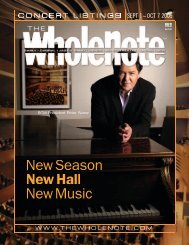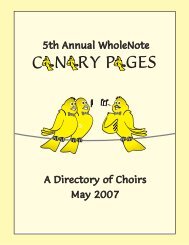y Alma Mahler which her husband, uponthe advice of Sigmund Freud, edited andarranged to have published in 1910 as recompensefor his ill-considered ban on herown composing career upon their marriagein 1902. Accompanied by pianist MarcBourdeau, Boulianne brings to life the captivatingcharm of these scarce remnants ofAlma’s youthful dreams.—Daniel FoleyMarie-Josée LordMarie-Josée Lord; Orchestre Métropolitain;Giuseppe PietraroiaATMA ACD2 2649“A star is born”should be theheadline in TheWholeNote on theoccasion of theannouncement ofthe 2012 JUNOnominees. I speakin particular of onecontender for Classical Record of the Year,Vocal and Choral Category, the self-titledMarie-Josée Lord. Alas, it takes a long timeto become an overnight success. Lord hasbeen charming Quebec audiences with hermagnificent voice since her debut in thefall of 2003. Be it Liu, Mimi, Nedda, SuorAngelica or Carmen — passionate, dispossessedor heartbroken heroines are her royaldomain. But there is also Gershwin’s Bessand Marie-Jeanne of Plamondon’s super-hitStarmania. Each of these roles gets transformedby Lord’s smoky, fascinating voice.Soft and velvety in the lower registers, ithas a lovely, robust and crystalline qualityin the upper range. To call her “a soprano”is like describing Mozart as “a composer.”Her voice has the power to send shiversdown your spine, make you grip the armrestand lean forward in your seat. This artist isall her own, not emulating anybody else’sstyle, rendering her instantly recognizableand unforgettable. With all this attentionon the vocals, one barely notices thecompetent, if sometimes ham-fisted playingby the Orchestre Métropolitain underGiuseppe Pietraroia.These selections are well known, but youhave never heard them sung like this. I haveyet to see Lord sing on stage, but if thisrecording is anything to go by, it will be amemorable occasion.—Robert TomasFauré – Requiem; Cantique de Jean RacinePhilippe Jaroussky; Matthias Goerne;Choeur et Orchestre de Paris; Paavo JärviVirgin Classics 50999 070921 2Fauré once described his requiem massas “gentle in temperament, as I am myself.”He believed that a funeral service shouldprovide comfort and solace to those inmourning, and therefore chose the liturgicaltexts “which are prayer-like, which pleadfor something andwhich look towardsthe heavens ratherthan towards hell.”For example, Fauréabandoned the fiery“Dies Irae” exceptfor a fleeting appearancein the “Liberame” and conductor Paavo Järvi, despite largeforces at his disposal, respects Fauré’s intention,bringing forth the transcendent beautyof the piece by using a light touch throughout.At the start, the orchestra and chorusare barely perceptible with the subsequentcrescendo sublimely subtle and gradual. Itis within the harmonic framework that thecomposer imbues this work with emotionand Järvi ensures a warm and lush deliverythrough the subtle metamorphoses. Warm,rich and deep tones from baritone MatthiasGoerne mirror the orchestration perfectly,while a delightfully unconventional twist isprovided by engaging the pure, yet maturetimbre of countertenor Philippe Jarousskyfor the “Pie Jesu.”The other choral works included on thisCD are the deeply inspirational and gorgeouslyperformed Cantique de Jean Racine,the playfully quirky Pavane and the recordingdebut of a youthful (and hence morevolatile) work, Super flumina Babylonis (Bythe rivers of Babylon). There is one instrumentalwork, the magnificent Elégie for celloand orchestra, featuring Orchestre de Paris’superb principal, Eric Picard.—Dianne WellsConcert Notes: The Hart House Singerspresent Fauré’s Requiem and Tavener’s ThreeSongs with soloists and orchestra underDavid Arnot-Johnston, in the Great Hall,Hart House, on March 24 at 8pm. The Choirof the Church of St. Nicholas Birchcliffefeatures Fauré’s Requiem and Messe Basse ina programme of music for Lent on March 30at 7:30pm. The Amadeus Choir will performFauré’s Requiem at All Saints KingswayAnglican Church at 4pm on April 1.Ponchielli–La GiocondaDeborah Voigt; Elisabeth Fiorillo; EwaPodles; Richard Margison; Carlo Guelli;Carlo Colmbara; Gran Teatre del Liceu;Daniele CallegariArtHaus Musik 107 291This latest videoproduction of LaGioconda from 2005is most notable forits staging and setsby architect andtheatre designer PierLuigi Pizzi. Thestylized set of interconnectingstairwaysand a colour schemedominated by greyswith accents of deepblue, scarlet and orange creates an all-pervasivesense of approaching death in decayingVenice during the terror of the dreadedCouncil of Ten. The effect is so dazzlingthat one is reminded of frescoes of the 16thcentury Paolo Veronese.It is an extremely difficult and expensiveopera to produce mainly for its demand oftop singers, six in all, in all vocal ranges.In today’s world there are no more Callases,Tebaldis, Bergonzis and Pavarottis (evenDomingo is now a baritone), the great starsof the late 20th century who brought theirglory to this formidably demanding opera.Today we have Deborah Voigt, one of thefew remaining dramatic sopranos with staminaand power to cope with the gruelling titlerole. Her voice and characterization havewhat it takes and it’s a great thrill to hearher carry over the top of the choruses andthe orchestra. In terms of power Canadiantenor Richard Margison surely belts out themurderous high notes, but the Italianate inflectionand charm of the likes of a Pavarottiis unfortunately missing. Still … the beautifularia “Cielo e il mar” is very successfuland warmly applauded. Another great creditto the performance is Ewa Podles, whosesympathetic portrayal and mellifluous altovoice of the abused blind mother is simplyheartbreaking. Neither Carlo Guelfi as theevil Barnaba nor Elisabetta Fiorillo as Laurameasures up to the historic legends in thesemajor roles, but the conducting of DanieleCallegari is outstanding especially in the exquisitelychoreographed, beautifully executed“Dance of the Hours.”—Janos GardonyiEARLY & PERIOD PERFORMANCEBach – Keyboard ConcertosAlexandre Tharaud; Les Violons du Roy;Bernard LabadieVirgin Classics 50999 087109 2 5I eagerly wait fornew CDs of Bach toarrive and this onedoesn’t disappoint.In fact, it goes onmy list of favourites.I admire AlexandreTharaud for puttingthe piano behind theorchestra in a position more conducive tothe spirit of chamber music. It makes for anintimate listening experience.I also love the touch Tharaud coaxes fromthe piano, so reminiscent of the harpsichord.Playing with Les Violins du Roy and theirbaroque bows you would expect a harpsichordbut Tharaud performs with such acrisp, clean and articulate technique that youdon’t miss it at all. Tharaud also maintainsa lyrical and flowing line in the espressivomovements. For the quicker movementsthe brisk tempos are infectious and remind72 thewholenote.comMarch 1 – April 7, 2012
us that Vivaldi, Corelli and Torelli wereestablishing the violin concerto at the sametime that Bach was creating his keyboardmasterworks. Bach also relied on a practicethat was common at the time by adaptingand transcribing works originally writtenfor solo violin or oboe for harpsichord. Youcan hear many of these reminders in thevirtuosic Concerto in D Minor BWV1052.The Concerto in D Major BWV1054 andConcerto in G Minor BWV1058 are reworkingsof two violin concertos. The Concertoin F Minor BWV1056 is brief but exquisiteand clearly demonstrates the Italian inspiration.The g minor concerto is also betterknown in its original version for violin.Tharaud’s stunning technique and fingerworksuit this Italian style and he plays witha concise and crisp articulation.In Tharaud’s wonderful transcriptionof the Adagio from the oboe concerto byMarcello he sings the melodic line with avelvet tone and heart-stopping intensity.I was also transfixed by his performanceof the Concerto for Four Keyboards andOrchestra in A Minor BWV1065. He recordedthe four parts individually.The performances in all the concertibreathe with the spirit of Italian andBaroque. The music dances with energyand vitality. The ensemble with the stringsis tight and precise. I keep returning tothis excellent CD with its unique and excitingperformances.—Christina Petrowska QuilicoThe Flute King –Music from the Court of Frederick the GreatEmmanuel PahudEMI Classics 0 84230 2The programmeof this two-CD setof music from thecourt of the fluteplayingPrussianemperor Frederickthe Great providesan intriguing snapshotof a significanttime and place in the flute’s repertoire. Thefirst disc features concertos by C.P.E. Bach,Benda, Frederick II himself and his fluteteacher Quantz, in which flutist EmmanuelPahud is accompanied by the geographicallyappropriate Kammerakademie Potsdam. Theplaying from everyone involved is pleasantenough, though a sameness of musicalcharacter and lack of nuance pervade theperformance of these pieces, some of whichrequire extra imaginative “juice” to bringthem completely off the page. On the otherhand, the inherent dynamic theatricality ofCPE Bach’s Concerto in A Minor isn’t exploitedwell enough.Disc Two presents us with J.S. Bach’sMusical Offering trio sonata and sonatasby Frederick, his sister Anna Amalia, J.F.Agricola and C.P.E. Bach, and here theplaying is imbued with greater creativity ofspirit. Pahud, perhaps inspired by his colleagues,harpsichordist Trevor Pinnock, cellistJonathan Manson and violinist MatthewTruscott, plays with increased variety ofcolour and articulation. J.S. Bach’s inestimabletrio sonata receives an affectionate andthoughtful rendition, and of special note areAnna Amalia’s Sonata in F Major and theopening Siciliano of Frederick’s Sonata inB Minor.Although it’s unfortunate that this recordingdoesn’t take more of Quantz’s own interpretiveadvice into account, it’s still a worthycompilation of music from 18th century,flute-focused Potsdam.—Alison MelvilleConcert Notes: Alison Melville curates andperforms in “A Musical Bestiary” featuringvocal and instrumental music about creaturesof earth, sea, sky and myth for theToronto Consort at Trinity-St. Paul’s CentreMarch 23 and 24. Melville is also involvedin “The Bird Project” which will be featuredin a noon-hour multi-media presentation atWalter Hall, University of Toronto on March15. And finally, Melville’s Ensemble Polarishas a new CD Uncharted Waters which willbe reviewed in the April WholeNote.classical & beyONDSchubert – Piano SonatasBoris ZarankinDoremi DHR-71153If the listenerdidn’t know itbefore, this CDconfirms that BorisZarankin possessesan ardent empathywith Schubert. Fromthe opening bars ofthe first movementof the great Sonata in B-Flat Major, markedmolto moderato, there is almost a quasi religiousawakening and as the music unfolds,further dimensions are revealed that onedoes not hear in other versions of this familiarwork. Well, not quite. Hearing Zarankinconjured up the performance by ValeryAfanassiev recorded live at the LockenhausFestival in 1986 that has lingered in mymemory as an interpretation with the sameintense, poetic introversion. However, listeningto that performance once again, as attractiveas it is, Zarankin is the more poetic,realizing the tragedy of Schubert playing outthe last chapter of his life.In both sonatas Boris Zarankin is in aclass of his own, fully justifying his venturinginto such frequently charted repertoire.Zarankin has his own ideas about playingthese sonatas but I sense that they are alsoSchubert’s.These recordings were made last Augustin Glenn Gould Studio in Toronto andengineered by Clive Allen who is responsiblefor the eminently truthful and dynamic,wide-range sound.—Bruce SurteesBruckner – Symphony No.4London Symphony Orchestra; BernardHaitinkLSO Live LSO0716Bruckner – Symphony No.4Orchestre Métropolitain du GrandMontréal; Yannick Nézet-SéguinATMA ACD2 2667This is BernardHaitink’s third commercialrecording ofBruckner’s popularSymphony No.4, inthis instance usingthe Nowak editionof the score andculled from a pairof live performancesfrom June 2011. TheLondon SymphonyOrchestra is unquestionablyan outstandingensemblewith an exceptionallyimpressivestring section, seatedhere in the European style with the violinsdivided right and left and the double bassesto the left rear. The orchestra respondsadroitly to the stolid octogenarian Haitink, acelebrated master of elucidating the ofttimesshambolic structure of Bruckner’s symphonies.Ultimately, however, all this excellenceis undermined by the problematic acousticsof London’s Barbican Centre. The resplendentstring tone is noticeably recessed andthe sound-stage, though wide, lacks depth.Some tremendous brass playing, particularlyfrom the closely-miked horn section, offersconsiderable recompense however.No such problems mar the lively soundof Nézet-Séguin’s conventionally seatedMétropolitain string ensemble, though theyare a comparatively lean and slightly underpoweredforce compared to the LSO ensemble,with two fewer players in each section.The response from the judiciously balancedfull orchestra is consistently precise, electricand blessed with a contagious enthusiasmand attention to dynamic shading that renderseven the most meandering passagesof Bruckner’s rambling discourse riveting.The performance utilizes the 1936 Haasedition in splendid studio sound recorded atQuébec’s Église Saint-Ferdinand. Some mayconsider Nézet-Séguin’s overtly theatricalapproach rather over-the-top in the Scherzomovement, where he drives his forces intoa Berliozian frenzy, but for my money thisis one of those rare Bruckner performancesthat commands my complete attention. Theclear winner? The home team!—Daniel FoleyMarch 1 – April 7, 2012thewholenote.com 73
- Page 2 and 3:
Spring 2012 atChoral SpectacularCel
- Page 5 and 6:
Volume 17 No 6 | March 1 - April 7,
- Page 7 and 8:
~E TO|oNTOCºNSO|tpresentsT‰ O|iG
- Page 9 and 10:
turn on a dime. Ballet is an extrem
- Page 11 and 12:
Beat by Beat / Art of SongROY THOMS
- Page 13 and 14:
Mozart: Cosi fan tutteMar 8-10, 7:3
- Page 16 and 17:
the Tokyo for 14 years (1981 to 199
- Page 18 and 19:
LEGENDS INLITTLE ROOMSTHE INTIMATE
- Page 20 and 21:
Memory? Forget ItbenjAMIN steinIt m
- Page 22 and 23: well represented this month. Fauré
- Page 24 and 25: JUNOS and Bridgesandrew timarBefore
- Page 26 and 27: But back to the demise of jazz club
- Page 28 and 29: matter, the “town,” in most cas
- Page 30 and 31: And there’s more,MUCH moreIf you
- Page 32 and 33: The WholeNote ListingsThe WholeNote
- Page 34 and 35: • 7:30: Toronto Opera Repertoire.
- Page 36 and 37: Three Cantors. Angus Sinclair, acco
- Page 38 and 39: Browning, director. 15186 Yonge St.
- Page 41 and 42: Edward Johnson Bldg., 80 Queen’s
- Page 43 and 44: Rococo Theme; Rimsky-Korsakov: Capr
- Page 45 and 46: conductor. George Weston Recital Ha
- Page 47 and 48: • 2:00: Visual and Performing Art
- Page 49 and 50: Sacred Musicfor a SacredSpaceGood F
- Page 51 and 52: Saturday March 24• 7:30: Brock Un
- Page 53 and 54: under Workshops); 4pm Ronnie Haywar
- Page 55 and 56: Momo’s Bistro664 The Queensway, E
- Page 57 and 58: • Mar 16 10:00 and 2:00: Royal Co
- Page 59 and 60: AUDITIONS / MUSICIANS WANTEDCOUNTER
- Page 61 and 62: Institute in Ottawa.I applied for b
- Page 63 and 64: Joey and Toby Tanenbaum Opera Centr
- Page 65 and 66: tion; Suzuki/Traditional Strings Ca
- Page 67 and 68: www.tafelmusik.org/tbsitbsi@tafelmu
- Page 69 and 70: PAMELA MargLESSilence: Lectures and
- Page 71: hands, was evidently the last major
- Page 75 and 76: Adding up to three CDs and a DVD (A
- Page 77 and 78: Hear music from the soundtrack on
- Page 80: 416.593.4828tso.caCONCERTS AT ROY T
















